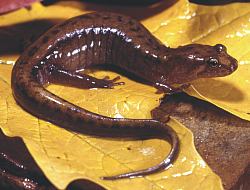Biology:Allegheny Mountain dusky salamander
| Allegheny Mountain dusky salamander | |
|---|---|

| |
| Scientific classification | |
| Domain: | Eukaryota |
| Kingdom: | Animalia |
| Phylum: | Chordata |
| Class: | Amphibia |
| Order: | Urodela |
| Family: | Plethodontidae |
| Subfamily: | Plethodontinae |
| Genus: | Desmognathus |
| Species: | D. ochrophaeus
|
| Binomial name | |
| Desmognathus ochrophaeus Cope, 1859
| |

| |
| Range of D. ochrophaeus | |
The Allegheny Mountain dusky salamander (Desmognathus ochrophaeus) is a species in the Plethodontidae (lungless salamander) family native to eastern North America.
Distribution and habitat
It is found in the eastern United States, as well as in the Niagara Glen Nature Reserve adjacent to the lower Niagara River in southern Ontario, and a single disjunct population in southern Quebec, Canada.[2] Its natural habitats are temperate forests, rivers, intermittent rivers, freshwater springs, and rocky areas.[1]
Description
Desmognathus ochrophaeus is a medium-sized salamander that can grow to about 10 cm in length. Adults are brownish and can have a widely variable coloration pattern. Usually, it has a light stripe down the back, with a row of dark spots on the centre and flanked by dark pigments. As in all members of the genus, the hind legs are larger and stouter than the front legs. This species belongs to the "lungless salamander" family (Plethodontidae), whose adults must keep their skin moist to breathe. It is a somewhat terrestrial salamander that can be found under stones, logs, and bark near springs, streams, and other areas where the ground is saturated with water.[3]
Protection
Ontario's Endangered Species Act, 2007, protects D. ochrophaeus from being killed, harmed, or possessed. Salamanders are protected on Niagara Parks Commission property under the Niagara Parks Act, which makes it illegal to hunt, trap, or molest any animal without a government permit. A Dusky Salamander Recovery Team has been established to develop a strategy for the recovery of this species and the related northern dusky salamander (D. fuscus).[3]
Canadian populations of D. ochrophaeus are divided into two segments, each of which is designated endangered under Schedule 1 of the Species at Risk Act. The first is the Carolinian population, native to Ontario, which received endangered status in 2009.[4] The second population, the Appalachian population, is found in a small area of Quebec and was designated as endangered in April 2021.[5] Previously, from 1998 to 2007, the populations were treated together as a COSEWIC "Species of Special Concern."[4][5]
References
- ↑ 1.0 1.1 IUCN SSC Amphibian Specialist Group (2022). "Desmognathus ochrophaeus". IUCN Red List of Threatened Species 2022: e.T59253A193364750. doi:10.2305/IUCN.UK.2022-1.RLTS.T59253A193364750.en. https://www.iucnredlist.org/species/59253/193364750. Retrieved 12 May 2023.
- ↑ Frost, Darrel R. (2014). "Desmognathus ochrophaeus Cope, 1859". Amphibian Species of the World: an Online Reference. Version 6.0. American Museum of Natural History. http://research.amnh.org/vz/herpetology/amphibia/Amphibia/Caudata/Plethodontidae/Plethodontinae/Desmognathus/Desmognathus-ochrophaeus.
- ↑ 3.0 3.1 Royal Ontario Museum and Ontario Ministry of Natural Resources (2008). "Allegheny Mountain dusky salamander". Ontario's Biodiversity. Royal Ontario Museum. http://www.rom.on.ca/ontario/risk.php?doc_type=fact&id=314&lang=en.
- ↑ 4.0 4.1 "Allegheny Mountain Dusky Salamander (Desmognathus ochrophaeus), Carolinian population". Government of Canada. 2 February 2021. https://species-registry.canada.ca/index-en.html#/species/963-646.
- ↑ 5.0 5.1 "Allegheny Mountain Dusky Salamander (Desmognathus ochrophaeus), Appalachian population". Government of Canada. 23 April 2021. https://species-registry.canada.ca/index-en.html#/species/1004-679.
Further reading
- Cope ED. 1859. On the Primary Divisions of the SALAMANDRIDÆ, with Descriptions of Two New Species. Proc. Acad. Nat. Sci. Philadelphia 11: 122-128. (Desmognathus ochrophæa, new species, p. 124).
Wikidata ☰ Q2705341 entry
 |


